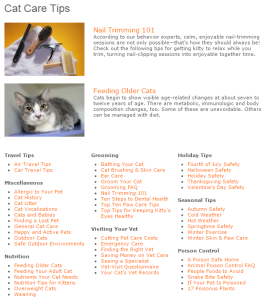Cat 411
By Karen Burgess, DVM
What should be considered before getting a cat?
The introduction of any pet should first be discussed with all family members or potential human housemates. Cats are a long-term commitment living up to twenty years. If unsure, ensure that no family members have an allergy to cats (typically to their saliva or dander). If uncertain or unfamiliar with cats in general, it is a good idea to first visit and interact with cats in an animal shelter type setting.
What should I look for in a cat?
Ideally one would have the chance to spend at least an hour observing a prospective cat’s behavior. Ensure that they are willing to be handled by humans and seem comfortable with all family members. Cats that have been handled by people from a young age and raised by a mother cat tend to be better options (bottle raised kittens may have more issues with behavior in the future). Observe for any signs of a respiratory infection (sneezing, nasal discharge), has solid stools, uses the litterbox, and has a good overall appetite.
What do I need to own a cat?
It is best to have the following supplies before bringing your new cat home.
- Cat carrier, some shelters may provide a cardboard variety, plastic versions are typically more convenient and durable and are often available second hand at garage sales etc.
- Litterbox, purchase the biggest available (even consider a concrete mixing container from Home Depot, often more affordable and larger than real litterboxes), avoid uncovered versions
- Litter and scooper, clumping, non-scented preferable, commercial scoopers are typically most durable
- Water and food bowls, separated
- Cat food, try and find out what your new kitty is already eating and obtain a small amount of this to start with, having some additional cans of tasty cat food may also serve as a nice treat
- Scratching post, horizontal and vertical, many types available, taller the better as cats typically want to scratch while in a full stretch, ask Healthy Paws for additional recommendations on scratching in general
- Cat toys, various types available, favorites tend to be wand toys, balls, food dispensing balls, catnip products
- Cat bed, covered often preferred
- Cat hair brush and nail clippers for grooming
- Cat collar, breakaway type (one that if a cat jumps and is caught by the collar will break away thus preventing choking), bell can be helpful in keeping track or your new friend
Where should my new cat stay?
In the beginning it is best to have a small room (laundry room, bathroom as example) set up as the cat room. Put food, water, litterbox, bedding, scratching post, and toys in this room and use it as a home base. Fill the litterbox with 2 inches minimum of litter and place food and water bowls as far away from the litter as possible. Cats like hiding spots. Keeping a carrier, covered cat bed, or even a box with one open side in the room may provide added security. Use of the scratching post can be encouraged by sprinkling it with catnip or hanging a toy from the top. As your cat and you feel more comfortable, gradually allow more access to other areas of the house.
Do I need to cat-proof my home?
Cats by nature are inquisitive animals often preferring vertical surfaces to allow a better view the lay of the land. Small areas are also favorite hiding places for cats. Take a look around the house before introducing your new cat to look for any potential areas that might require blocking off. Look at all surfaces, including tops of cabinets/higher surfaces to ensure nothing will be harmed if your cat starts exploring. Some common safety concerns for cats include…
- Recliners
- Washers and dryers/piles of laundry that unwittingly contain a sleeping cat
- Doors left open to the outside
- String, yarn, rubberbands, and hairties that may be ingested causing life-threating intestinal blockage
- Trash cans that do not contain lids
- Dangling electrical or window blind cords
- Breakable objects that may fall during cat exploration (look for museum or earthquake wax to secure objects)
- Household plants
- Fireplaces, ensure have a screen
- Boxes that are unintentionally thrown out with a cat inside
- Burning candles
- Closed closets or drawers that a cat may have hidden in
What about the first day at home?
Once home, take your new cat into their special room in their carrier. Close the door, get situated sitting on the floor, open the carrier door, and wait patiently kitty decides how they want to explore. Some cats will come bounding out and be excited about their new surroundings, others may hide for hours in the crate only coming out to explore when left completely alone. Be patient, even shy cats can make wonderful pets; they just may require a bit more time to adjust.
When should the first veterinary visit be?
New cats should have a complete examination by a veterinarian within a week of coming home to ensure their overall health.
What are some good general cat resources?
- The ASPCA (www.aspca.org/pet-care/cat-care.com) has a vast amount of helpful information for cat owner. Below is a sample of available articles….
- Cat Behavior Associates (www.catbehaviorassociates.com) also has a variety of helpful articles regarding cats.


